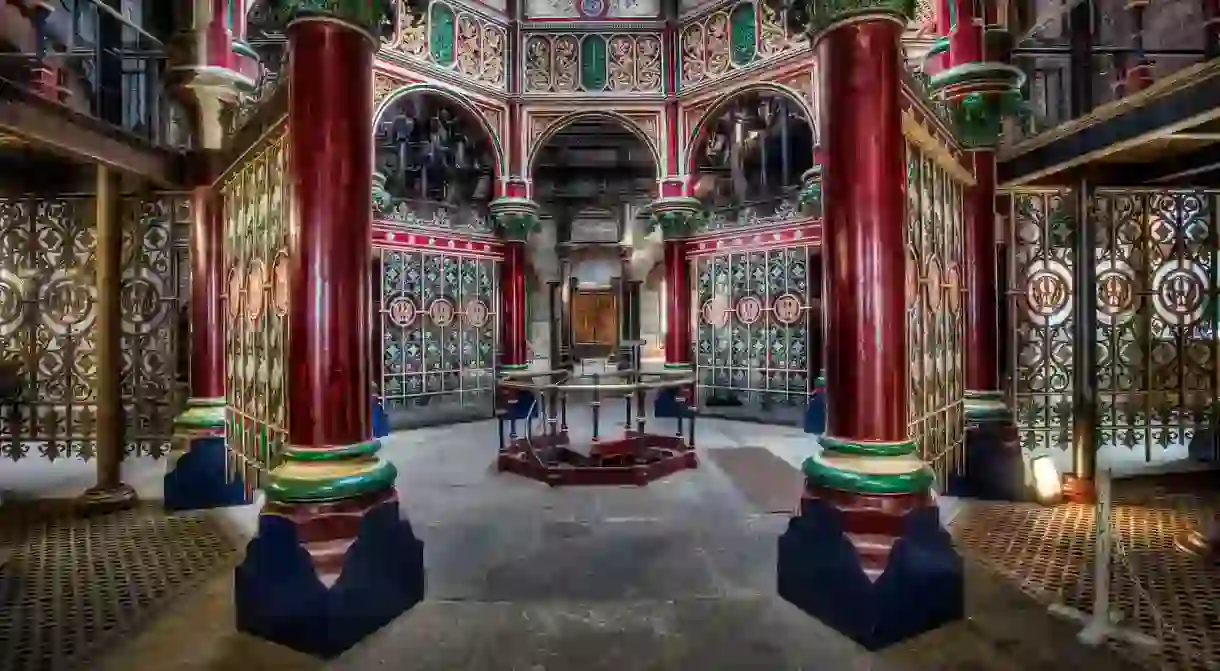Forgotten Gems: Crossness Pumping Station

Nicknamed the Cistern Chapel, Crossness Pumping Station by Joseph Bazalgette is a joyously decorative feat of Victorian industrial design, which inadvertently helped eradicate cholera in London.
Crossness Pumping Station was cherished by the Victorians for its revolutionary engineering. It was built to liberate Londoners from “The Great Stink” of 1858, which rendered the Thames as one huge foul-smelling and disease-ridden cesspit. Despite its rather unglamorous purpose, this municipal building was a shrine to civic engineer Joseph Bazalgette’s cutting-edge design, with its distinctive dog-toothed brickwork exterior and a bells-and-whistles Romanesque interior.

The pièce de résistance is undoubtedly the cathedral-like “Octagon” at the heart of the Beam Engine House. It’s a masterpiece of colourful intricate ironwork with fig leaves adorning the top of vermillion red columns, surrounded by hundreds of unique stone carvings, including an effigy of Bazalgette himself.

“Everywhere you look there are decorative elements you wouldn’t expect, such as stone benches that would have been covered with potted plants and surrounded by elaborate tilework,” reveals Mike Jones, a volunteer at Crossness Engines Trust. “We’ve lost bits that were quite important too. The chimney was amazing, but it was demolished in 1957-58 and the main building’s mansard roof was removed in the 1930s, as well as a beautiful turret clock that used to face the river.”

The Victorian aristocracy came in their droves via boat when the sewage plant opened in 1865, including 17 lords, 300 MPs and the Archbishops of York and Canterbury. All were equally fascinated by Bazalgette’s progressive design. The four huge beam engines were even ceremoniously named after members of the royal family, including the Prince Consort.

Crossness was built by Bazalgette to relieve London of its most odorous problem at the time – “the Great Stink”. A swelteringly hot summer in 1858 brought the city to its knees due to the overwhelming stench of the Thames, which was the result of the capital’s relentless dumping of untreated waste into the river. MPs were even dousing the curtains of Parliament in chloride and lime to mask the smell. Unsurprisingly, a bill was passed to “purify the Thames” in a record 18 days, with Bazalgette called in as a matter of urgency to come up with a solution.

Commissioned by the Metropolitan Board of Works, Bazalgette’s plan was to take the sewage as far as possible from the city, with the rural Erith marshes chosen for its remote location. From here, the waste was safely pumped into the river after high tide and carried out to sea. Unintentionally, what Bazalgette had created was a super-efficient sewage system that also happened to eliminate several of London’s most deadly waterborne diseases – most importantly cholera.

Almost a century later, the pumping station was decommissioned in 1956, with its Romanesque grandeur given over to rust and vandalism. The building was set for demolition, but, according to rumour, no-one could dismantle the colossal engines, the largest of their type in the world, standing 24.4m (80ft) tall and weighing a hefty 250 tonnes. The building’s wrought iron intransigence eventually won it recognition for its historic significance and as a fine example of Victorian industrial architecture. It was given Grade I status in 1970, with Thames Water ironically diverting the money it had originally put aside for its demolition to the Crossness Engines Trust for its restoration.

“Crossness is a tangible memorial to what Bazalgette did. He isn’t like Isambard Brunel who’s famous for his bridges and tunnels,” says Jones. “Bazalgette is an unsung hero but he’s arguably as important at Brunel.
“He’s had an impact on London that I don’t think many people realise. He even designed roads including Shaftesbury Avenue and Charing Cross and as a result of building the sewers he also created the Victoria and Albert embankments; he’s had a marked impact on the area around the Thames and how it looks. There’s a small memorial to him opposite Embankment Station near Charing Cross. Next year will actually be the 200th anniversary of his birthday, so we’re looking to celebrate that through a series of events.”

Find out more about Crossness Pumping Station here.













